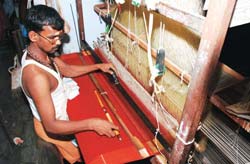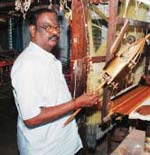Kanjeevarams in a bind
The shimmer of the famed sari has begun to fade for there are few weavers left in Kanchipuram willing to dedicate their time and skills to produce pure contrast saris, known in common parlance as Kanjeevarams, which are considered works of art by themselves. Is this the start of the end for this once lucrative business? N. Varadarajan goes into the details.


Endangered species
The salesman was telling only a partial truth; the fact is there are few weavers left in Kanchipuram willing to dedicate their time and skills to produce pure contrast saris, known in common parlance as Kanjeevarams, which are considered works of art by themselves. So, what makes these saris unique? While many handloom manufacturers across the country prefer the tieand-dye method to get the contrast, Kanchipuram is famous for its knotting and interlocking techniques— the border and the pallav woven separately with the body of the sari. The technique is known as “korvai”. “The double warp and weft, the special drape, the skill-set of the weaver and his inherent devotion to his work separated Kanjeevaram from the rest of the handloom industry,” says L.S. Angamuthu, Assistant Director (Weaving), Weaver’s Service Centre at Kanchipuram.

Nalli Kuppusamy
|
No helping hands
Why has this unique art of “korvai” seen a gradual decline? Simply because there has been a steady decline of “helpers” over the years. The master weaver, typically, has a loom in his house and the entire family, including women, helps with the process. These helping hands are disappearing as people opt for more certain and less strenuous sources of livelihood. These are in the form of hardware and electronics companies setting up shop in the vicinity of Sriperambudur (Nokia and Samsung, for example). For others, there are opportunities in auto ancillaries. The state’s scheme for women—where they get compulsory employment of 10 days a month in the private sector at the wage of Rs 80 per day, outside the weaving industry—hasn’t helped the cause either. “The lure of the (definite) Rs 800 per month outside the house has affected work at home where they helped with the more menial but necessary tasks related to weaving,” says Nalli Kuppusamy, founder and promoter of the famous Nalli Silks.

R. Sivakumar
While the cooperative stores definitely ensure quality (of silk and zari), the number of customers has started declining, leading to higher and higher levels of inventories. “This has led to fewer and staggered orders. Weavers now find themselves getting jobs just once in three months for which they get a fixed fee that is inadequate to feed their families,” says Chandrasekar.
Take, for instance, M. Loganathan, 30, and his father S. Manickam, 68, both weavers, who were busy drying out the starched warp in the late afternoon when we visited Kanchi. “We get work for just 15 days in three months and Rs 3,000 at the end of it. So, we supply to private retailers in the interim,” Loganathan says. They supply to the ailing Kanchi Pallavan Society. “I will be the last of my generation to do weaving. These days, we are treated with such scant respect that families are not willing to give us their daughters in marriage.”

A.V. Chandrasekar
Some weavers have sold their land to the adjacent industries and have settled down to comfortable retirement. Says Baskar Shah, Manager of M. Linku Sha Silks, a showroom that gets supplies from MGR Silk Handloom Weavers Co-Op Society (a smaller society): “We had 500 weavers three years ago, but now only 300 weavers are left. We do have steady demand for wedding saris, which we are not able to meet.” It’s more of the same at Thiruvalluvar Society, which now has 2,000 members, down from 3,000 three years ago.
{mosimage} The silver lining
Is this the beginning of the end for the famous Kanjeevaram sari? Probably not, if corrective action is taken. At the Kamakshi Amman Colony, which almost exclusively houses weavers, P.D. Narasimmam, a master weaver, is happy with the work he is doing for Nalli. His two sons share his passion. The saris he supplies are sizeable in value and have intricate zari work, which gives him room for creativity and generates a decent income.
The challenge lies in encouraging the other Narasimmams of Kanchipuram. “A weaver needs a comfortable environment to work in, both physical and mental. Today, he sees multinational companies offering a better environment and facilities to people around him. These people are making more money doing a less onerous task,” says R. Sivakumar, Managing Director of the famous Rm K. Visvanatha Pillai & Sons (RmKV), a retail house known for its innovative thinking.
RmKV has helped design a pneumatic handloom along with the Silk Board, which relieves great pressure on the weaver’s leg (particularly during intricate designing). The difference is akin to that between a manual and motorised sewing machine. This is implemented throughout RmKV’s loom, though others are adopting it slowly. “The greater challenge is to bring the customer back to the sari— the garment itself is going out of vogue,” he adds.
The company has also applied for a patent for the KV technique (named after Sivakumar’s late brother). Through this technique, interlocking gets done automatically on the loom, increasing productivity, and saving hard labour. Pure contrast saris are now available at RmKV showrooms in all their splendour.
Sivakumar himself is a passionate master weaver and has a loom that he uses in his spare time. He also scours works and illustrations on global art and culture (including Indian) to bring different metaphors into silk. “Today, the traditional family business is not binding, as there are so many opportunities outside. However, if we bring back the respectability to weaving, provide sound training and environment, weaving could become a viable profession again,” he says. Sivakumar’s late brother K. Visvanathan, an IIT graduate, came back to build on the weaving dream at the turn of the century and succeeded. So will many others, hopefully.











